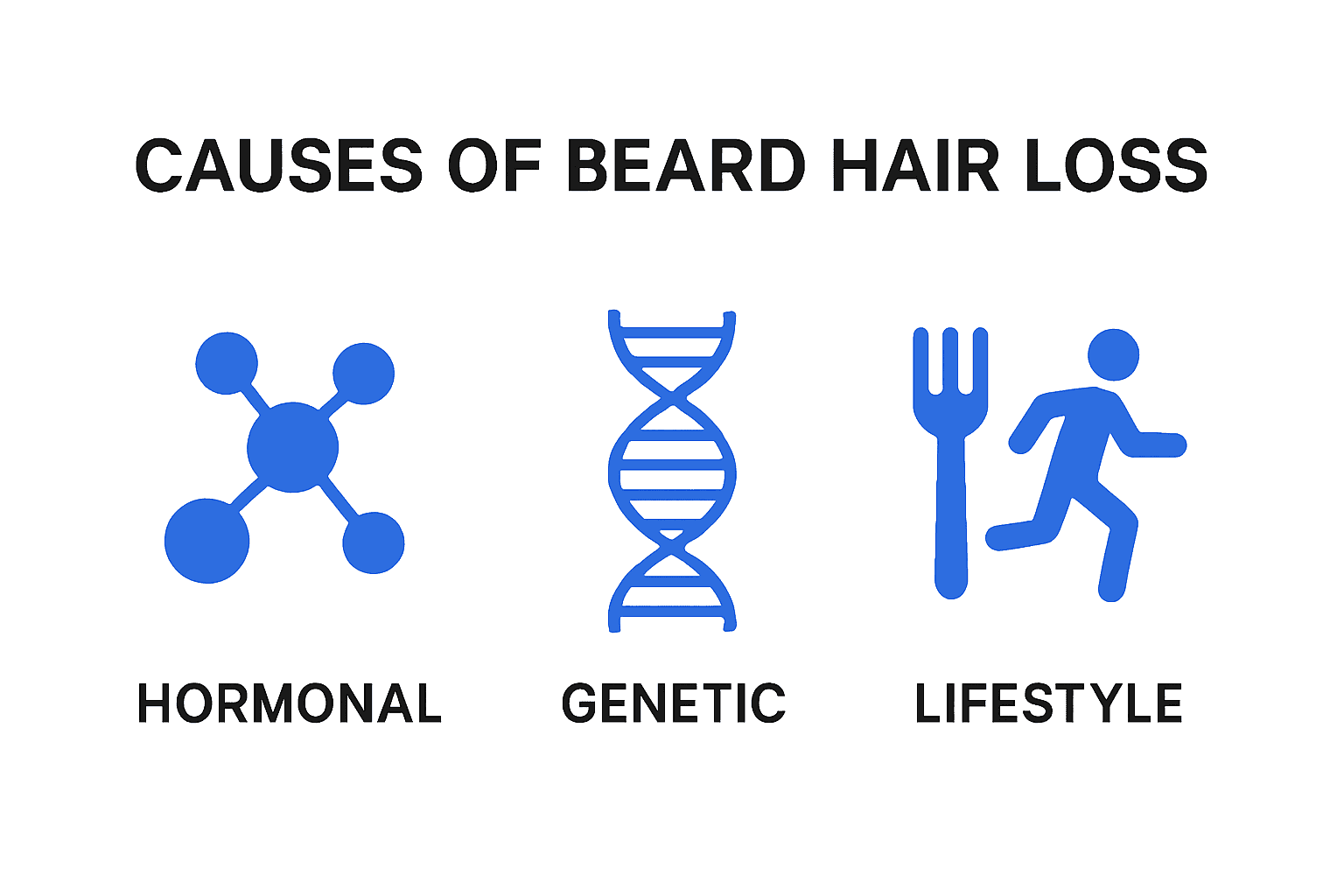Blog
Learning Materials
Beard Hair Loss: Causes, Tracking, and Solutions 2025
Updated: July 11, 2025

Beard hair loss is on the rise and more men are seeking answers than ever before. Here’s something unexpected. Up to 75 percent of men see noticeable beard regrowth within a year using the latest targeted treatments. Most guys guess it's just genetics or age, but the real story is far more complex. Nutrition, stress, and cutting-edge technology now play a bigger role than most realize, changing how facial hair loss gets solved in 2025.
Table of Contents
- Common Causes Of Beard Hair Loss
- How To Track Beard Growth Progress
- Effective Treatments And Personalized Solutions
- Choosing The Right Products And Brands
Quick Summary
| Takeaway | Explanation |
|---|---|
| Hormonal and Genetic Factors are Key | Elevated dihydrotestosterone (DHT) levels and genetic predispositions significantly influence beard hair loss, making understanding individual patterns crucial for effective management. |
| Nutritional Health Matters | Nutritional deficiencies in biotin, zinc, iron, and protein can compromise hair follicle health and contribute to beard thinning, emphasizing the importance of a balanced diet. |
| Tracking Beard Growth is Essential | Utilizing photographic documentation and digital measurement tools can help monitor beard growth trends and detect potential hair loss early, allowing for proactive interventions. |
| Personalized Treatment is Effective | Implementing a combination of medical, technological, and lifestyle interventions tailored to individual needs offers the best chances for restoring beard growth. |
| Choosing the Right Products | Selecting scientifically backed treatments and personalized products based on genetic, hormonal, and health factors can enhance beard restoration efforts. |
Common Causes of Beard Hair Loss
Beard hair loss can be a frustrating and complex issue affecting men of various ages. Understanding the underlying causes is crucial for developing an effective management strategy. Multiple factors contribute to beard hair loss, ranging from genetic predispositions to lifestyle and health conditions.
Hormonal Triggers and Genetic Influences
Hormonal imbalances play a significant role in beard hair loss. Research from the American Hair Loss Association reveals that dihydrotestosterone (DHT), a powerful derivative of testosterone, can dramatically impact hair follicle health. When DHT levels are elevated, it causes hair follicles to shrink and progressively weaken, leading to reduced beard growth and eventual hair loss.
Genetic factors are equally critical in determining beard hair loss patterns. Some men are genetically predisposed to more sensitive hair follicles that react more intensely to hormonal changes. This genetic sensitivity means that even normal hormonal fluctuations can trigger significant beard hair thinning or complete loss in certain individuals.

Nutritional and Health Considerations
Nutritional deficiencies can substantially contribute to beard hair loss. Clinical studies published in the Journal of Clinical and Aesthetic Dermatology demonstrate that insufficient intake of key nutrients like biotin, zinc, iron, and protein can compromise hair follicle health. These nutrients are essential for maintaining robust hair growth mechanisms and supporting the complex biological processes that sustain healthy facial hair.
Certain medical conditions and chronic health issues can also trigger beard hair loss. Autoimmune disorders such as alopecia areata can cause sudden, patchy beard hair loss. Thyroid disorders, chronic stress, and systemic inflammatory conditions can disrupt normal hair growth cycles, leading to noticeable beard hair thinning or complete loss.
Lifestyle and Environmental Factors
External factors significantly impact beard hair health. Chronic stress, poor sleep patterns, and excessive exposure to environmental pollutants can accelerate hair loss. Dermatological research from Stanford University indicates that prolonged stress triggers hormonal cascades that directly interfere with hair follicle functioning, potentially accelerating beard hair loss.
Lifestyle choices like smoking, excessive alcohol consumption, and poor nutrition can further exacerbate beard hair loss. These habits compromise overall body health and disrupt the intricate biological mechanisms responsible for maintaining healthy hair growth.
For men experiencing persistent beard hair loss, understanding personalized hair growth patterns becomes crucial. Professional assessment and targeted interventions can help identify specific causative factors and develop tailored solutions for beard hair restoration.
Here is a summary table comparing the main causes of beard hair loss described above, to help you quickly scan each factor and its effects.
| Cause Category | Key Examples/Triggers | Effects on Beard Hair |
|---|---|---|
| Hormonal & Genetic | DHT elevation, genetic follicle sensitivity | Follicle shrinkage, thinning |
| Nutritional & Health | Biotin, zinc, iron, protein deficiency; autoimmune or thyroid | Weak follicles, patchy/thinning loss |
| Lifestyle & Environmental | Stress, lack of sleep, pollutants, smoking, alcohol, poor diet | Accelerated loss, poor growth |
How to Track Beard Growth Progress
Tracking beard growth progress requires a systematic and precise approach that combines multiple measurement techniques and documentation strategies. Understanding how to effectively monitor facial hair development can provide valuable insights into hair health, potential growth patterns, and early detection of hair loss issues.
Photographic Documentation and Digital Measurement

Research published in the Archives of Dermatology confirms that photographic methods offer a reliable way to track beard growth. Establishing a consistent documentation process involves taking high-resolution, well-lit photographs from multiple angles at regular intervals. Professional photographers recommend using neutral background, consistent lighting, and maintaining the same facial expression to ensure accurate comparative analysis.
Digital measurement tools and smartphone applications have revolutionized beard growth tracking. Fertility and Sterility research highlighted computerized methods that objectively measure facial hair growth with remarkable precision. These technological solutions can help men quantify growth rates, density, and potential changes over specific time periods.
Comprehensive Growth Tracking Parameters
Effective beard growth monitoring extends beyond simple length measurements. Key parameters to track include hair density, thickness, color consistency, and growth direction. Journal of Cosmetic Science studies demonstrated sophisticated image analysis techniques that provide granular insights into facial hair characteristics.
Men should establish a tracking routine that includes:
- Weekly photographs from consistent angles
- Detailed notes on growth rate and texture changes
- Measurement of beard length using precise tools
- Observations about potential patches or uneven growth
Below is a table outlining key parameters and suggested tools for tracking beard growth progress effectively.
| Parameter | Example Tools/Methods | Frequency |
|---|---|---|
| Photographic Record | Smartphone/Camera, consistent setup | Weekly |
| Length Measurement | Ruler, digital calipers | Weekly |
| Density/Thickness | Image analysis apps, visual notes | Weekly |
| Color Consistency | Comparative photos | Monthly |
| Growth Direction | Visual inspection, notes | Monthly |
| Patch/Pattern Notes | Written log, annotated photos | As noted |
Technological and Professional Assessment
Advanced hair analysis tools like our personalized tracking system can provide comprehensive insights into beard growth patterns. Professional dermatological assessments complement personal tracking by offering expert perspectives on potential underlying health factors affecting facial hair development.
Consistent tracking helps identify potential issues early, allowing for proactive interventions. Whether experiencing natural growth variations or addressing potential hair loss concerns, a methodical approach provides crucial data for understanding individual beard growth dynamics.
Utilizing a combination of photographic documentation, digital measurement tools, and professional assessments creates a holistic strategy for monitoring beard growth progress. This comprehensive approach empowers individuals to gain deeper insights into their facial hair health and potential growth trajectories.
Effective Treatments and Personalized Solutions
Addressing beard hair loss requires a multifaceted approach that combines medical interventions, lifestyle modifications, and personalized treatment strategies. Understanding the nuanced options available can help men develop targeted solutions for their specific beard hair loss challenges.
Medical and Pharmacological Interventions
Research on alopecia areata barbae reveals complex autoimmune mechanisms that impact beard hair growth. Medical treatments have advanced significantly, offering multiple therapeutic approaches. Topical corticosteroids represent a primary treatment option, with clinical studies showing promising results in beard hair regrowth.
Cutting-edge treatments include Janus kinase (JAK) inhibitors, which have demonstrated remarkable effectiveness. These innovative medications can potentially restore beard hair growth in up to 75% of cases within 12 months. Dermatologists often recommend a combination of treatments tailored to individual hormonal profiles, genetic predispositions, and specific hair loss patterns.
Technological and Non-Invasive Solutions
Low-level laser therapy (LLLT) emerges as a breakthrough non-invasive treatment. Scientific research indicates that LLLT can significantly increase hair density and stimulate growth mechanisms. This technology offers a promising alternative for men seeking treatments without surgical interventions.
Additional non-invasive approaches include:
- Nutritional supplementation targeting hair follicle health
- Specialized scalp and beard care regimens
- Stress management techniques
- Hormone-balancing protocols
Here is a table summarizing various treatment options for beard hair loss, including medical, technological, and non-invasive methods as discussed above.
| Treatment Type | Example Approaches | Key Benefits |
|---|---|---|
| Medical | Corticosteroids, JAK inhibitors | Promotes regrowth, addresses cause |
| Technological | Low-level laser therapy (LLLT) | Non-invasive, boosts density |
| Nutritional | Supplements: biotin, zinc, protein | Supports follicle health |
| Care Regimen | Specialized beard products, routines | Improves scalp/beard environment |
| Stress/Hormone | Stress management, balancing protocols | Reduces loss triggers |
Personalized Treatment Strategies
Comprehensive hair growth analysis becomes crucial in developing targeted beard restoration strategies. Advanced diagnostic tools now enable precise assessment of individual hair loss patterns, allowing for unprecedented levels of personalization.
A holistic approach considers multiple factors:
- Genetic predisposition
- Hormonal balance
- Nutritional status
- Environmental influences
- Individual metabolic characteristics
Men experiencing beard hair loss should consult healthcare professionals who can provide comprehensive evaluations. Each treatment plan must be uniquely crafted, recognizing that universal solutions rarely address the complex nature of individual hair loss experiences.
The future of beard hair loss treatment lies in personalized, data-driven approaches that combine medical expertise, technological innovation, and individual health insights. By embracing these comprehensive strategies, men can effectively address beard hair loss and restore confidence in their facial hair growth.
Choosing the Right Products and Brands
Selecting appropriate products for beard hair health requires a strategic approach that considers individual hair characteristics, underlying health conditions, and scientifically validated treatment options. Understanding the nuanced landscape of beard care products can significantly impact hair growth and overall follicle health.
Scientific Evaluation of Topical Treatments
Research published in the Journal of Clinical Medicine demonstrates that topical treatments play a crucial role in beard hair restoration. Dermatological experts recommend products containing scientifically backed ingredients that target specific hair loss mechanisms. Corticosteroid-based treatments, for instance, have shown promising results in addressing localized beard hair loss.
Microneedling represents an innovative approach to beard hair restoration. Studies indicate that this technique stimulates growth factors like vascular endothelial growth factor (VEGF) essential for hair follicle proliferation. When evaluating products, men should prioritize formulations that combine multiple scientifically validated ingredients targeting hair follicle health and stimulation.
Advanced Treatment Technologies
Low-level laser therapy (LLLT) research from Skin Appendage Disorders highlights the effectiveness of specific light wavelengths in promoting hair growth. Red and infrared light technologies have demonstrated particular promise in stimulating beard hair development. Men should look for products and devices that offer:
- Clinically tested light wavelengths
- Consistent and targeted application methods
- Scientifically documented growth stimulation mechanisms
Personalized Product Selection Strategies
Discovering personalized hair growth solutions requires a comprehensive approach that goes beyond generic product recommendations. Key considerations for selecting beard care products include:
- Individual genetic predisposition
- Specific hair loss patterns
- Underlying health conditions
- Hormonal profile
- Environmental factors
Consultation with dermatological professionals becomes crucial in developing a targeted product strategy. Each individual's beard hair restoration journey requires a unique combination of treatments, technologies, and specialized care products.
The future of beard hair care lies in personalized, scientifically backed solutions that address individual needs with precision. By combining advanced technologies, targeted treatments, and comprehensive understanding of personal hair health, men can develop effective strategies for maintaining and restoring beard hair growth.
Frequently Asked Questions
What are common causes of beard hair loss?
Common causes include hormonal imbalances, genetic predispositions, nutritional deficiencies, and lifestyle factors such as stress and environmental pollutants.
How can I track my beard growth progress effectively?
Tracking can be done through regular photographic documentation, measuring length and density, and utilizing digital measurement tools to analyze growth patterns.
What treatments are effective for beard hair loss?
Effective treatments include medical interventions like corticosteroids and JAK inhibitors, non-invasive technologies like low-level laser therapy, and personalized supplementation for nutritional support.
How do I choose the right products for beard care?
To choose the right products, consider scientifically backed ingredients, evaluate personal hair characteristics, and consult with professionals for personalized recommendations.
See Real Change in Your Beard: Stop Guessing and Start Tracking
Struggling with patchy beard growth or unexpected hair loss can feel overwhelming. When your beard thins or stalls, it is easy to waste time trying random solutions. But the truth is, every beard has its own story. The article above highlights how beard hair loss often starts with complex factors like hormonal shifts, nutrition, stress, and genetics. Without a clear way to track the root causes and monitor your progress, it is almost impossible to fix the problem for good.

Now is the time to take control with personalized technology. MyHair.ai uses powerful AI to analyze your unique beard growth patterns. Upload a quick scan and receive a data-driven assessment so you see which factors are holding you back. Get matched with expert-backed solutions and product recommendations built just for you. Check your progress by tracking real changes over time in your beard’s health and thickness. Thousands have already discovered a smarter way to restore growth and gain confidence. If you are serious about a fuller beard, visit MyHair.ai and start your personalized growth journey today. For deeper insights, explore our guide to how to get thicker hair.